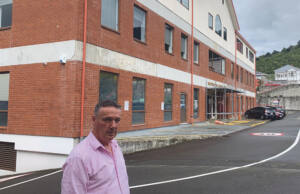
Michael Fitzsimons
The Archdiocese of Wellington’s Hill Street site in Thorndon, home of the archdiocesan Catholic Centre, is to be re-developed, following several adverse seismic assessment reports.
In February this year the archdiocese was notified in a detailed seismic assessment report that the Catholic Centre was a seismic risk, meeting only 20 per cent of the New Building Standard (NBS). A peer-review assessment done by another firm of engineers assessed the building at 40 per cent NBS.
‘When we looked into the costs of strengthening the centre, it became evident it wasn’t financially viable to strengthen it,’ says John Prendergast, archdiocesan General Manager.
‘We are now looking at a redevelopment of the entire site which will probably mean the demolition of the Catholic Centre, the demolition of [adjacent] Viard House and the demolition of the flats next door which we own.’
John Prendergast said the diocese had been exploring the potential development of the site before the adverse seismic reports because of the significant opportunities it offers for development.
‘It’s a lovely site, one of the best locations in Wellington, right across the road from parliament, close to the CBD, and up the road from the train station. It is currently underutilised from a commercial perspective so one of the objectives is to unlock some of the capital that is tied up in the property. That’s very important for the future of the archdiocese. The 20 per cent seismic assessment fast-forwarded that thinking.’
Work is now underway exploring the optimum use of the site. John says the site could be used for office accommodation for the diocese and commercial tenants, and it could include apartments as well. There is a spectrum of options to look at.
‘The archdiocese’s offices will be back on this site, incorporated within any re-development we do. The archbishop’s residential accommodation may also be here as well.’
Price Waterhouse Coopers (PWC) has been appointed to assist the diocese through the building process and to provide independent advice, said John.
‘PWC is very experienced in redevelopment projects for values-based organisations where you have the tension between mission-related needs and commercial needs. That is an ever-present tension.’
When the archdiocese received the seismic assessment report in February, the archdiocesan centre was immediately closed down and staff have been working in several different locations around Wellington and the Hutt Valley since February.
‘It has been discombobulating for staff but they have responded remarkably well.’
This month the staff who worked in the archdiocesan Catholic Centre are being relocated to office accommodation at 204 Thorndon Quay, Wellington.
‘We have taken a lease for four years with right of renewal for another year,’ said John. ‘We anticipate it will take that time to work through the process of re-developing the Hill Street site.’
The re-development of the Hill Street site is one element in a plan to address the archdiocese’s challenging financial situation, said John.
‘For a number of years the archdiocese has been incurring significant financial losses from its operations which wasn’t sustainable. With the Board and Cardinal John Dew, we developed a plan to address the situation by 2024.’
The plan included a significant re-structuring of staffing at the Catholic Centre, undertaken in 2020/21, said John.
‘Regrettably, the roles of about a third of our staff here at the Centre had to be disestablished. That has meant an annual saving of around $700K.’
The plan includes reducing overall operating costs, a longer-term investment strategy, and exploring new income streams.
John said that any re-development of the Hill Street site will not compromise the Cathedral and its immediate surroundings. The strengthening and re-development of the Cathedral is well-advanced with work due to be completed later next year. The major strengthening work was in the roof area, which has been completed and the focus now is on interior renovations and the exterior stonework. The budget for the whole project is about $12 million, of which just over $2 million is still to be raised.
‘The project benefitted hugely from a government shovel-ready grant of $4.5 million and the rest has come from grants, trusts, foundations and the generosity of individuals,’ said John.
‘The archdiocese is not able to contribute to the Cathedral project, so the support of the parish and individual parishioners and other donors has been instrumental to getting the project to a point where it is nearing completion.’